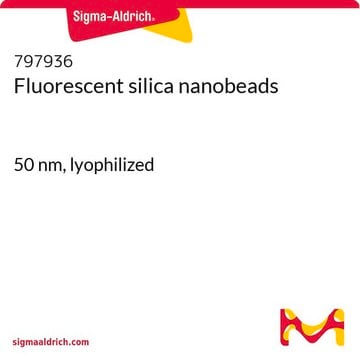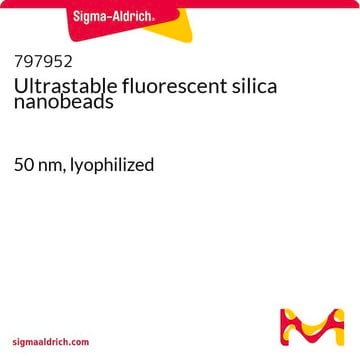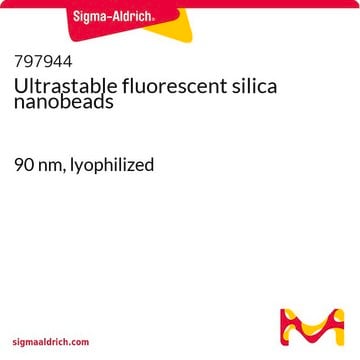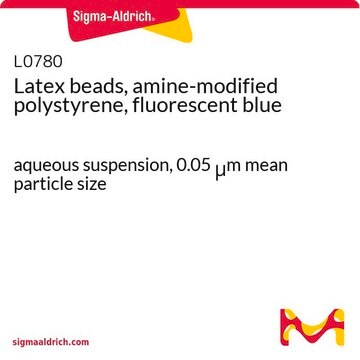The 25 nm nanobeads may exhibit high surface energy, making them prone to aggregation in solvent, which could explain the observed particle size of 300–800 nm in DLS measurements. It's also important to note that the 30% amplitude setting does not provide a clear indication of the actual power being applied during sonication. For better results, it is generally recommended to use a protocol of 1 second on with 3 seconds off for a total of 15 minutes under 400 Watts. Additionally, checking TEM images for the particle size, if available, may provide more accurate information on the actual size of the nanobeads.
797901
Ultrastable fluorescent silica nanobeads
25 nm, lyophilized
Sinônimo(s):
Fluorescent beads, Fluorescent nanoparticles, Silica nanoparticles
Selecione um tamanho
Selecione um tamanho
About This Item
Produtos recomendados
Nível de qualidade
Formulário
powder
tamanho de partícula
25 nm
fluorescência
λem 590 nm
Absorção UV
λ: 570 nm Amax
temperatura de armazenamento
2-8°C
Procurando produtos similares? Visita Guia de comparação de produtos
Categorias relacionadas
Aplicação
Código de classe de armazenamento
11 - Combustible Solids
Classe de risco de água (WGK)
WGK 3
Ponto de fulgor (°F)
Not applicable
Ponto de fulgor (°C)
Not applicable
Escolha uma das versões mais recentes:
Já possui este produto?
Encontre a documentação dos produtos que você adquiriu recentemente na biblioteca de documentos.
Os clientes também visualizaram
Artigos
RAFT polymerization controls chain growth, yields defined polymers without cytotoxic heavy metals like ATRP.
Biomaterials science integrates smart materials into biological research, requiring a deep understanding of biological systems.
-
I applied probe sonication on ice for 8 minutes at 30% amplitude. However, the DLS size measurement results showed the particle size of is around 300–800 nm, which differs from the product description (25 nm). How?
1 answer-
Helpful?
-
-
Are these PFA-fixable?
1 answer-
A specific PFA Fixation study is not performed on this material. The literature around this topic seems to suggest this is a possible use for this product and more details can be found below.
Chiou AE, Hinckley JA, Khaitan R, Varsano N, Wang J, Malarkey HF 5th, Hernandez CJ, Williams RM, Estroff LA, Weiner S, Addadi L, Wiesner UB, Fischbach C. Fluorescent Silica Nanoparticles to Label Metastatic Tumor Cells in Mineralized Bone Microenvironments. Small. 2021 Apr;17(15):e2001432. doi: 10.1002/smll.202001432. Epub 2020 May 28. PMID: 32462807; PMCID: PMC7704907.
Further application information can be found on the website through the link below.
Helpful?
-
-
what is dispersibility of this beads in water.
1 answer-
The nanopowder may be re-dispersed by adding water directly to the storage vial. It is recommended to add 1 mL of water per each 1 mg of nanoparticles to be re-dispersed, and probe sonicating on ice for 8 minutes at 30% amplitude or until the powder has completely re-dissolved.
Helpful?
-
Active Filters
Nossa equipe de cientistas tem experiência em todas as áreas de pesquisa, incluindo Life Sciences, ciência de materiais, síntese química, cromatografia, química analítica e muitas outras.
Entre em contato com a assistência técnica








